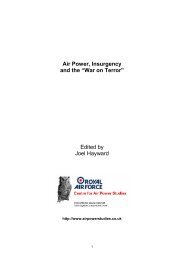Air Power, Insurgency and the âWar on Terrorâ - Prof. Joel Hayward's ...
Air Power, Insurgency and the âWar on Terrorâ - Prof. Joel Hayward's ...
Air Power, Insurgency and the âWar on Terrorâ - Prof. Joel Hayward's ...
You also want an ePaper? Increase the reach of your titles
YUMPU automatically turns print PDFs into web optimized ePapers that Google loves.
Starting with a Blank Sheet: Principles of War for a New Century<br />
Governmental Agencies, will be needed to c<strong>on</strong>fr<strong>on</strong>t successfully <str<strong>on</strong>g>the</str<strong>on</strong>g> varied challenges<br />
now facing us.<br />
5. Jointness. For centuries, <str<strong>on</strong>g>the</str<strong>on</strong>g> need for co-operati<strong>on</strong> between <str<strong>on</strong>g>the</str<strong>on</strong>g> services was usually<br />
c<strong>on</strong>sidered a sometimes desirable but seldom necessary occurrence. An excepti<strong>on</strong><br />
was often seen in Engl<str<strong>on</strong>g>and</str<strong>on</strong>g> where <str<strong>on</strong>g>the</str<strong>on</strong>g> British Way of War, as characterised by Basil H.<br />
Liddell Hart, was an indirect approach that relied <strong>on</strong> what could be termed peripheral<br />
operati<strong>on</strong>s. 480<br />
When <str<strong>on</strong>g>the</str<strong>on</strong>g> enemy – usually France – was too str<strong>on</strong>g to c<strong>on</strong>fr<strong>on</strong>t head <strong>on</strong>,<br />
amphibious operati<strong>on</strong>s in a different <str<strong>on</strong>g>the</str<strong>on</strong>g>atre – North America, <str<strong>on</strong>g>the</str<strong>on</strong>g> Middle East, Iberia–<br />
were c<strong>on</strong>ducted instead. In Lord Grey’s lovely phrase: <str<strong>on</strong>g>the</str<strong>on</strong>g> British Army was to be a<br />
projectile fired by <str<strong>on</strong>g>the</str<strong>on</strong>g> Royal Navy. 481<br />
In <str<strong>on</strong>g>the</str<strong>on</strong>g> US, such co-operati<strong>on</strong> was less evident. An Army-Navy Board existed for a century<br />
or so that was designed to co-ordinate <str<strong>on</strong>g>the</str<strong>on</strong>g> efforts of soldiers <str<strong>on</strong>g>and</str<strong>on</strong>g> sailors, but <str<strong>on</strong>g>the</str<strong>on</strong>g> two<br />
seldom had to actually work toge<str<strong>on</strong>g>the</str<strong>on</strong>g>r. That changed during World War II for two major<br />
reas<strong>on</strong>s. First, global war against major powers dem<str<strong>on</strong>g>and</str<strong>on</strong>g>ed close co-operati<strong>on</strong> to achieve<br />
victory. Sec<strong>on</strong>d, air power introduced a new dimensi<strong>on</strong> to war that also now required close<br />
co-operati<strong>on</strong> between <str<strong>on</strong>g>the</str<strong>on</strong>g> army <str<strong>on</strong>g>and</str<strong>on</strong>g> navy. When <str<strong>on</strong>g>the</str<strong>on</strong>g> mediums of <str<strong>on</strong>g>the</str<strong>on</strong>g> sea <str<strong>on</strong>g>and</str<strong>on</strong>g> l<str<strong>on</strong>g>and</str<strong>on</strong>g> were so<br />
clearly demarcated, sailors <str<strong>on</strong>g>and</str<strong>on</strong>g> soldiers could often ignore each o<str<strong>on</strong>g>the</str<strong>on</strong>g>r with few ill effects.<br />
When air power spanned both domains, arguments regarding priorities, targets, comm<str<strong>on</strong>g>and</str<strong>on</strong>g><br />
<str<strong>on</strong>g>and</str<strong>on</strong>g> c<strong>on</strong>trol, <str<strong>on</strong>g>and</str<strong>on</strong>g> allocati<strong>on</strong> of resources had to be solved using a joint approach. 482<br />
Even so, <str<strong>on</strong>g>the</str<strong>on</strong>g> services resisted. A main problem leading to defeat in Vietnam was <str<strong>on</strong>g>the</str<strong>on</strong>g><br />
parochialism <str<strong>on</strong>g>and</str<strong>on</strong>g> sometimes childish rivalry that existed am<strong>on</strong>g <str<strong>on</strong>g>the</str<strong>on</strong>g> services, especially<br />
between <str<strong>on</strong>g>the</str<strong>on</strong>g> <str<strong>on</strong>g>Air</str<strong>on</strong>g> Force <str<strong>on</strong>g>and</str<strong>on</strong>g> Navy, <str<strong>on</strong>g>and</str<strong>on</strong>g> <str<strong>on</strong>g>the</str<strong>on</strong>g> Army <str<strong>on</strong>g>and</str<strong>on</strong>g> Marines. It was <strong>on</strong>ly fur<str<strong>on</strong>g>the</str<strong>on</strong>g>r difficulties<br />
in war – fortunately of a relatively minor nature: in <str<strong>on</strong>g>the</str<strong>on</strong>g> botched Iranian hostage rescue<br />
<str<strong>on</strong>g>and</str<strong>on</strong>g> in Grenada – that forced reform. The result was <str<strong>on</strong>g>the</str<strong>on</strong>g> l<str<strong>on</strong>g>and</str<strong>on</strong>g>mark Goldwater-Nichols<br />
legislati<strong>on</strong> of 1986. 483 The move towards jointness occurred in Britain a bit earlier due<br />
largely to fiscal c<strong>on</strong>straints.<br />
Today it is difficult to see what <str<strong>on</strong>g>the</str<strong>on</strong>g> problem was all those years. Jointness works. Period.<br />
The questi<strong>on</strong> is, where do we go from here? In my view, jointness today tends to occur at<br />
<str<strong>on</strong>g>the</str<strong>on</strong>g> operati<strong>on</strong>al level of war; at <str<strong>on</strong>g>the</str<strong>on</strong>g> <str<strong>on</strong>g>the</str<strong>on</strong>g>atre. This is good, but more can be d<strong>on</strong>e. Is it time<br />
for jointness to move both up <str<strong>on</strong>g>and</str<strong>on</strong>g> down? The <strong>on</strong>ly joint tactical units in <str<strong>on</strong>g>the</str<strong>on</strong>g> US are in<br />
Special Operati<strong>on</strong>s Comm<str<strong>on</strong>g>and</str<strong>on</strong>g>. It is time that instead of air bases, naval ports <str<strong>on</strong>g>and</str<strong>on</strong>g> army<br />
forts, we have Joint Bases where all of <str<strong>on</strong>g>the</str<strong>on</strong>g> services live, train <str<strong>on</strong>g>and</str<strong>on</strong>g> work toge<str<strong>on</strong>g>the</str<strong>on</strong>g>r so that<br />
<str<strong>on</strong>g>the</str<strong>on</strong>g> first time a soldier meets an airman is not in combat overseas. At <str<strong>on</strong>g>the</str<strong>on</strong>g> same time, <str<strong>on</strong>g>the</str<strong>on</strong>g><br />
US is now experimenting with St<str<strong>on</strong>g>and</str<strong>on</strong>g>ing Joint Task Forces that could move <str<strong>on</strong>g>the</str<strong>on</strong>g> c<strong>on</strong>cept<br />
of jointness upwards a notch. Today, for example, we have air, l<str<strong>on</strong>g>and</str<strong>on</strong>g> <str<strong>on</strong>g>and</str<strong>on</strong>g> sea comp<strong>on</strong>ent<br />
196<br />
<str<strong>on</strong>g>Air</str<strong>on</strong>g> <str<strong>on</strong>g>Power</str<strong>on</strong>g>, <str<strong>on</strong>g>Insurgency</str<strong>on</strong>g> <str<strong>on</strong>g>and</str<strong>on</strong>g> <str<strong>on</strong>g>the</str<strong>on</strong>g> “War <strong>on</strong> Terror”





